University of Sunderland Finance Report: Money, Banking and Finance
VerifiedAdded on 2021/03/25
|18
|4887
|241
Report
AI Summary
This report, submitted by Tran Linh Trang to the Banking Academy of Viet Nam, analyzes the core functions of credit and capital markets in financing companies, households, and governments, differentiating between direct and indirect finance routes, and explaining the flow of funds. It further examines the role of the State Bank of Vietnam in achieving monetary policy goals, including the management of money supply and interest rates to achieve macroeconomic objectives like inflation control and economic growth. The report details the monetary policy framework in Vietnam, including its tools such as reserve requirements, open market operations, and lending facilities. It also discusses the State Bank's independence and its impact on the economy, especially in response to the COVID-19 pandemic, and analyzes the various tools used to maintain monetary stability and stimulate economic growth. The report provides detailed data and analysis on the impact of these policies.
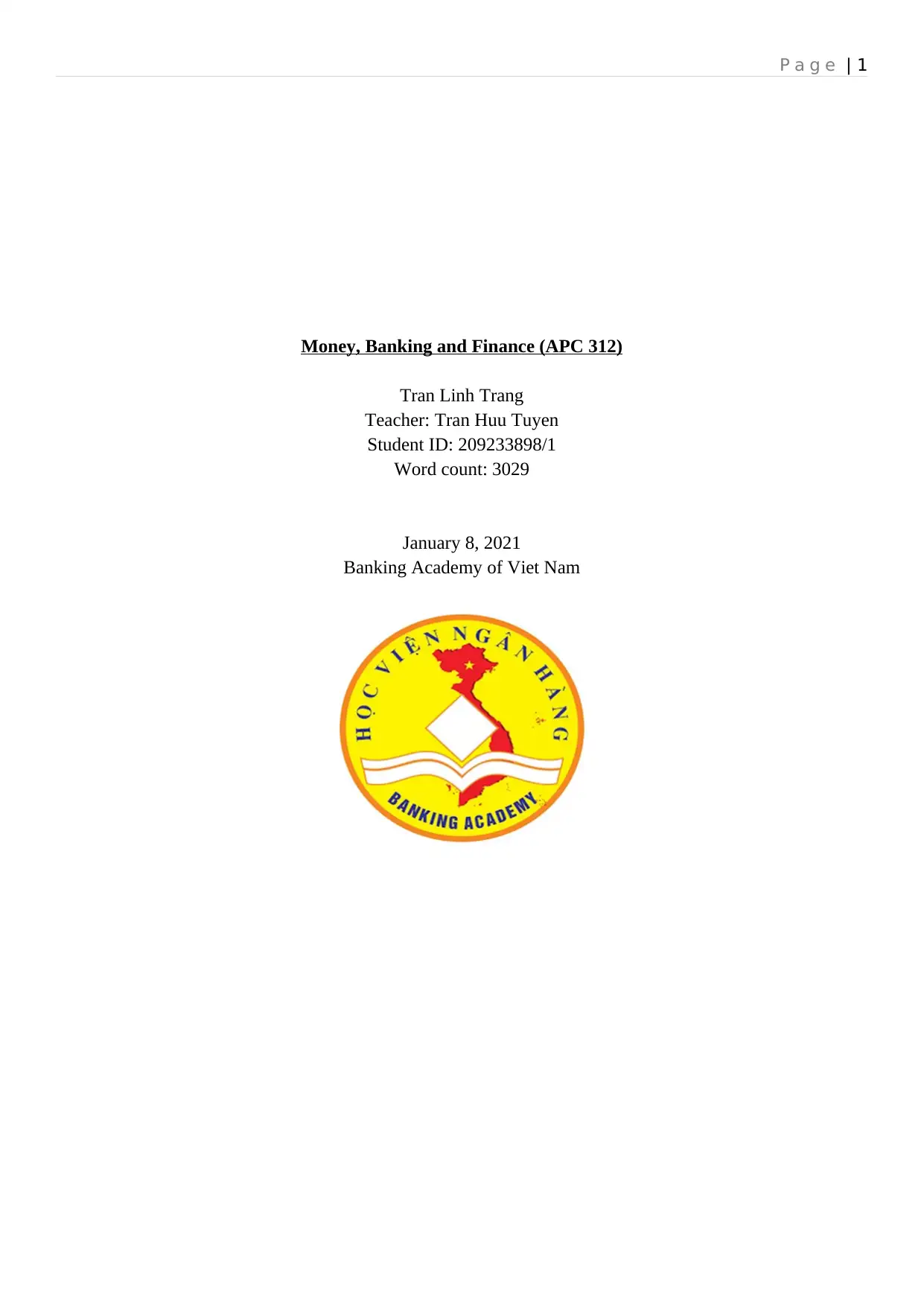
P a g e | 1
Money, Banking and Finance (APC 312)
Tran Linh Trang
Teacher: Tran Huu Tuyen
Student ID: 209233898/1
Word count: 3029
January 8, 2021
Banking Academy of Viet Nam
Money, Banking and Finance (APC 312)
Tran Linh Trang
Teacher: Tran Huu Tuyen
Student ID: 209233898/1
Word count: 3029
January 8, 2021
Banking Academy of Viet Nam
Paraphrase This Document
Need a fresh take? Get an instant paraphrase of this document with our AI Paraphraser
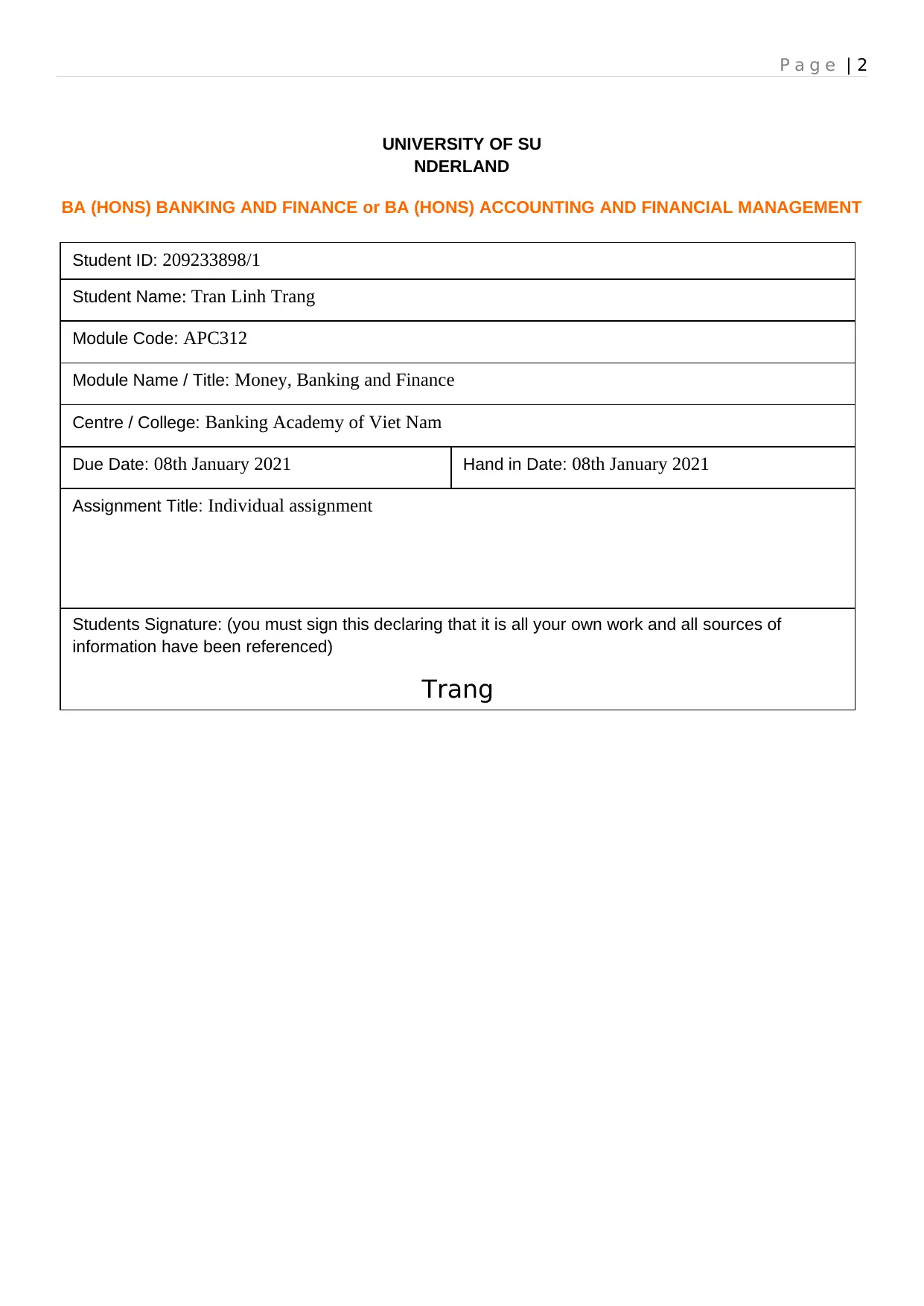
P a g e | 2
UNIVERSITY OF SU
NDERLAND
BA (HONS) BANKING AND FINANCE or BA (HONS) ACCOUNTING AND FINANCIAL MANAGEMENT
Student ID: 209233898/1
Student Name: Tran Linh Trang
Module Code: APC312
Module Name / Title: Money, Banking and Finance
Due Date: 08th January 2021
Centre / College: Banking Academy of Viet Nam
Hand in Date: 08th January 2021
Assignment Title: Individual assignment
Students Signature: (you must sign this declaring that it is all your own work and all sources of
information have been referenced)
Trang
UNIVERSITY OF SU
NDERLAND
BA (HONS) BANKING AND FINANCE or BA (HONS) ACCOUNTING AND FINANCIAL MANAGEMENT
Student ID: 209233898/1
Student Name: Tran Linh Trang
Module Code: APC312
Module Name / Title: Money, Banking and Finance
Due Date: 08th January 2021
Centre / College: Banking Academy of Viet Nam
Hand in Date: 08th January 2021
Assignment Title: Individual assignment
Students Signature: (you must sign this declaring that it is all your own work and all sources of
information have been referenced)
Trang
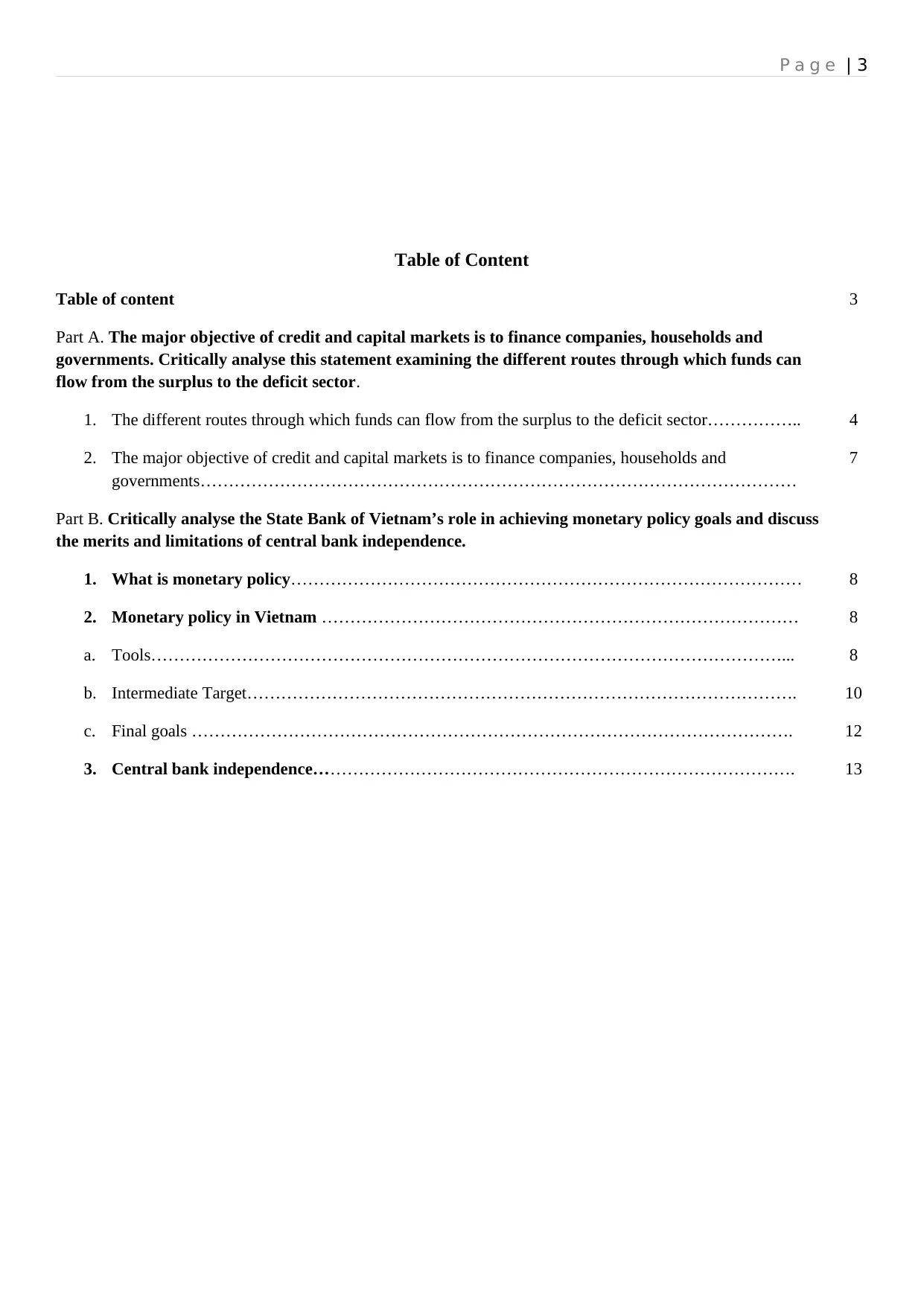
P a g e | 3
Table of Content
Table of content 3
Part A. The major objective of credit and capital markets is to finance companies, households and
governments. Critically analyse this statement examining the different routes through which funds can
flow from the surplus to the deficit sector.
1. The different routes through which funds can flow from the surplus to the deficit sector…………….. 4
2. The major objective of credit and capital markets is to finance companies, households and
governments……………………………………………………………………………………………
7
Part B. Critically analyse the State Bank of Vietnam’s role in achieving monetary policy goals and discuss
the merits and limitations of central bank independence.
1. What is monetary policy……………………………………………………………………………… 8
2. Monetary policy in Vietnam ………………………………………………………………………… 8
a. Tools…………………………………………………………………………………………………... 8
b. Intermediate Target……………………………………………………………………………………. 10
c. Final goals ……………………………………………………………………………………………. 12
3. Central bank independence…………………………………………………………………………. 13
Table of Content
Table of content 3
Part A. The major objective of credit and capital markets is to finance companies, households and
governments. Critically analyse this statement examining the different routes through which funds can
flow from the surplus to the deficit sector.
1. The different routes through which funds can flow from the surplus to the deficit sector…………….. 4
2. The major objective of credit and capital markets is to finance companies, households and
governments……………………………………………………………………………………………
7
Part B. Critically analyse the State Bank of Vietnam’s role in achieving monetary policy goals and discuss
the merits and limitations of central bank independence.
1. What is monetary policy……………………………………………………………………………… 8
2. Monetary policy in Vietnam ………………………………………………………………………… 8
a. Tools…………………………………………………………………………………………………... 8
b. Intermediate Target……………………………………………………………………………………. 10
c. Final goals ……………………………………………………………………………………………. 12
3. Central bank independence…………………………………………………………………………. 13
⊘ This is a preview!⊘
Do you want full access?
Subscribe today to unlock all pages.

Trusted by 1+ million students worldwide
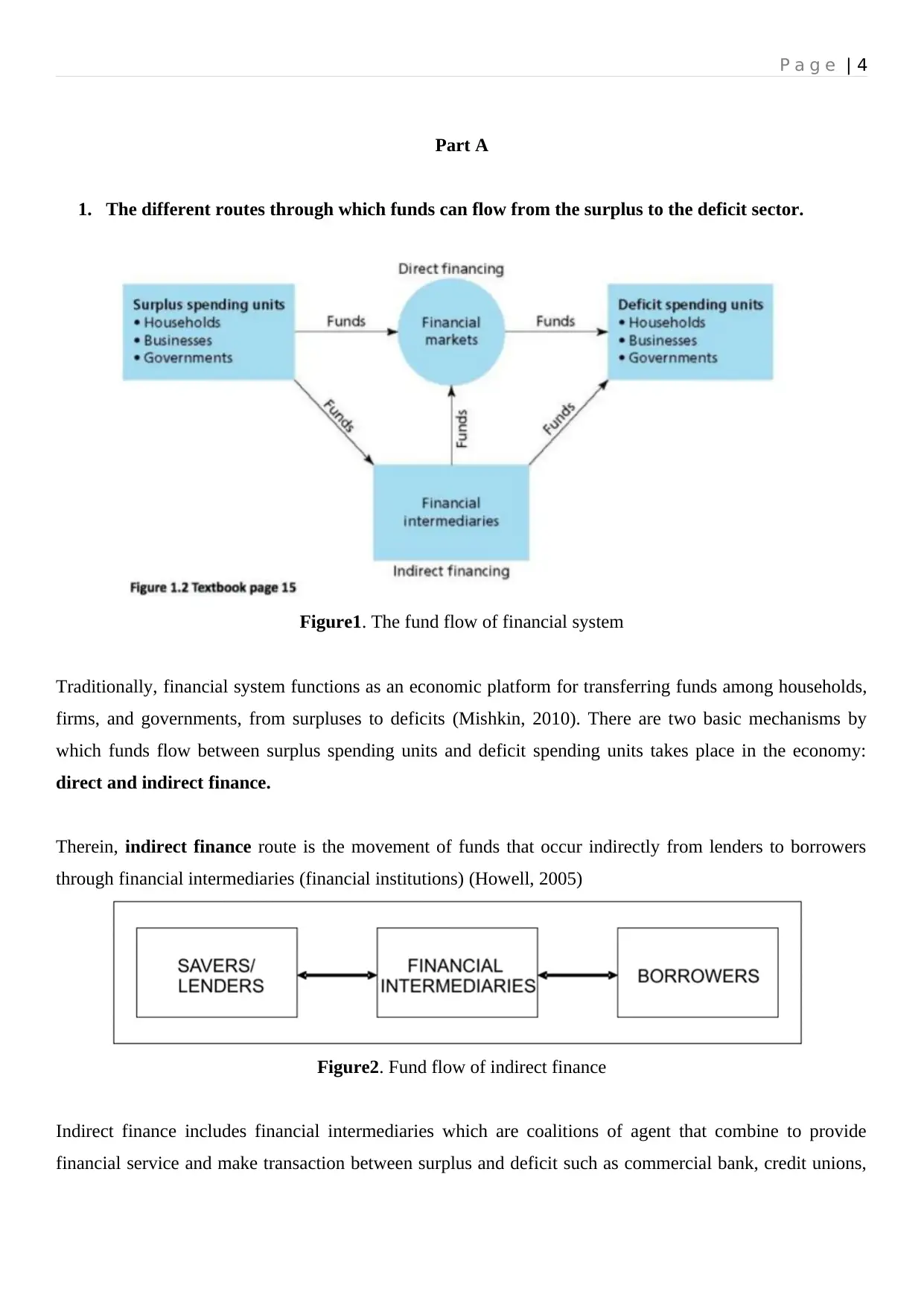
P a g e | 4
Part A
1. The different routes through which funds can flow from the surplus to the deficit sector.
Figure1. The fund flow of financial system
Traditionally, financial system functions as an economic platform for transferring funds among households,
firms, and governments, from surpluses to deficits (Mishkin, 2010). There are two basic mechanisms by
which funds flow between surplus spending units and deficit spending units takes place in the economy:
direct and indirect finance.
Therein, indirect finance route is the movement of funds that occur indirectly from lenders to borrowers
through financial intermediaries (financial institutions) (Howell, 2005)
Figure2. Fund flow of indirect finance
Indirect finance includes financial intermediaries which are coalitions of agent that combine to provide
financial service and make transaction between surplus and deficit such as commercial bank, credit unions,
Part A
1. The different routes through which funds can flow from the surplus to the deficit sector.
Figure1. The fund flow of financial system
Traditionally, financial system functions as an economic platform for transferring funds among households,
firms, and governments, from surpluses to deficits (Mishkin, 2010). There are two basic mechanisms by
which funds flow between surplus spending units and deficit spending units takes place in the economy:
direct and indirect finance.
Therein, indirect finance route is the movement of funds that occur indirectly from lenders to borrowers
through financial intermediaries (financial institutions) (Howell, 2005)
Figure2. Fund flow of indirect finance
Indirect finance includes financial intermediaries which are coalitions of agent that combine to provide
financial service and make transaction between surplus and deficit such as commercial bank, credit unions,
Paraphrase This Document
Need a fresh take? Get an instant paraphrase of this document with our AI Paraphraser
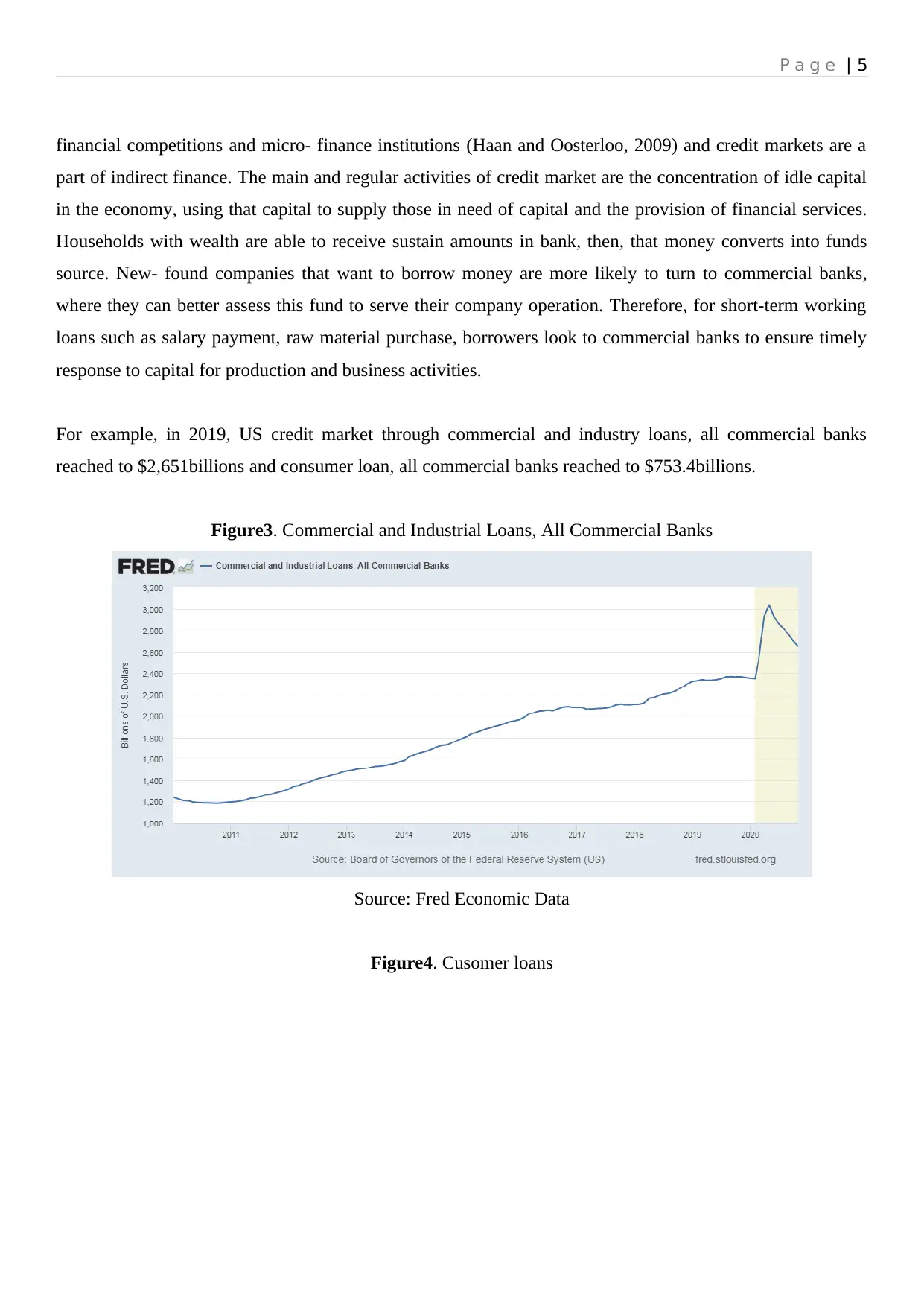
P a g e | 5
financial competitions and micro- finance institutions (Haan and Oosterloo, 2009) and credit markets are a
part of indirect finance. The main and regular activities of credit market are the concentration of idle capital
in the economy, using that capital to supply those in need of capital and the provision of financial services.
Households with wealth are able to receive sustain amounts in bank, then, that money converts into funds
source. New- found companies that want to borrow money are more likely to turn to commercial banks,
where they can better assess this fund to serve their company operation. Therefore, for short-term working
loans such as salary payment, raw material purchase, borrowers look to commercial banks to ensure timely
response to capital for production and business activities.
For example, in 2019, US credit market through commercial and industry loans, all commercial banks
reached to $2,651billions and consumer loan, all commercial banks reached to $753.4billions.
Figure3. Commercial and Industrial Loans, All Commercial Banks
Source: Fred Economic Data
Figure4. Cusomer loans
financial competitions and micro- finance institutions (Haan and Oosterloo, 2009) and credit markets are a
part of indirect finance. The main and regular activities of credit market are the concentration of idle capital
in the economy, using that capital to supply those in need of capital and the provision of financial services.
Households with wealth are able to receive sustain amounts in bank, then, that money converts into funds
source. New- found companies that want to borrow money are more likely to turn to commercial banks,
where they can better assess this fund to serve their company operation. Therefore, for short-term working
loans such as salary payment, raw material purchase, borrowers look to commercial banks to ensure timely
response to capital for production and business activities.
For example, in 2019, US credit market through commercial and industry loans, all commercial banks
reached to $2,651billions and consumer loan, all commercial banks reached to $753.4billions.
Figure3. Commercial and Industrial Loans, All Commercial Banks
Source: Fred Economic Data
Figure4. Cusomer loans
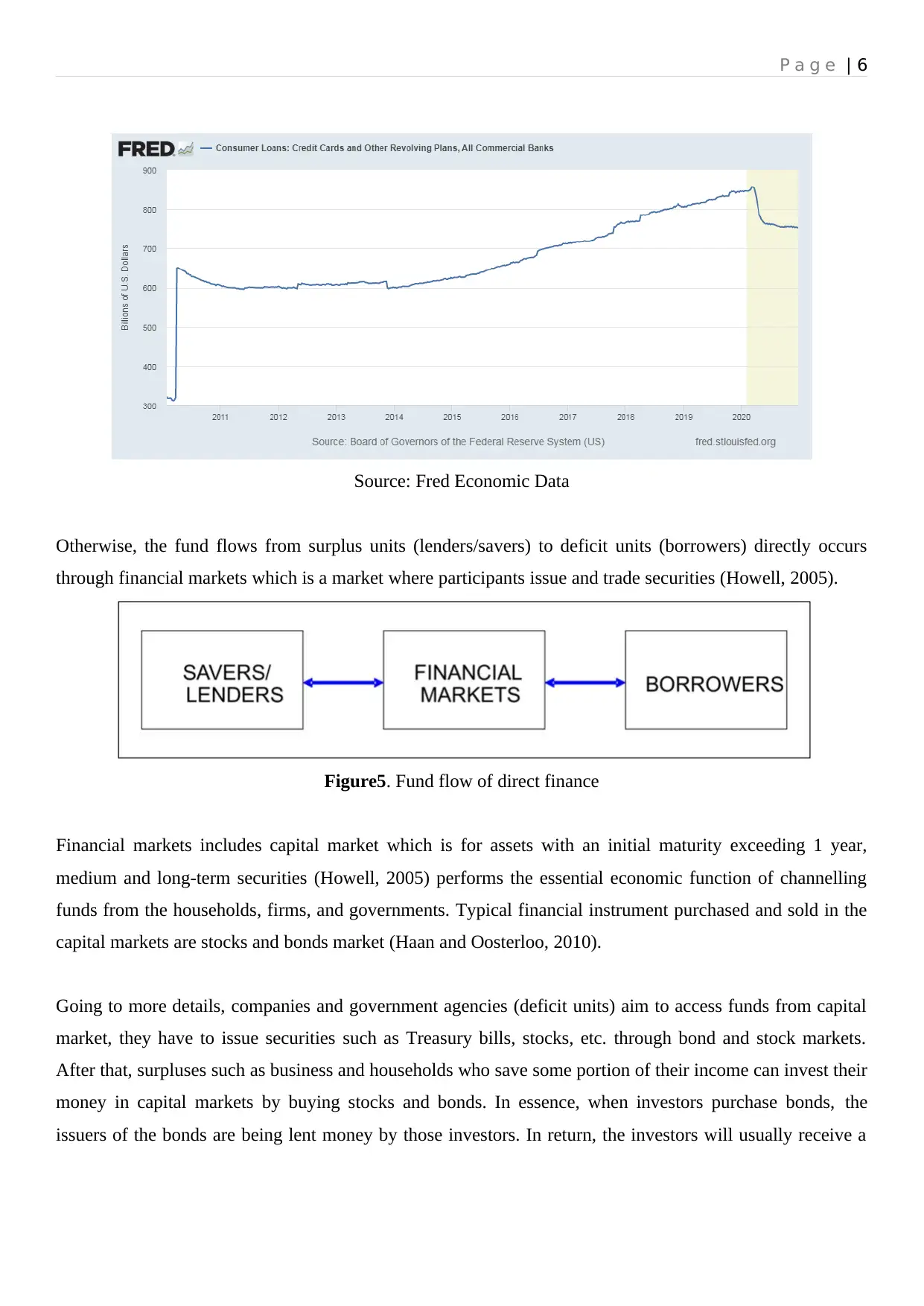
P a g e | 6
Source: Fred Economic Data
Otherwise, the fund flows from surplus units (lenders/savers) to deficit units (borrowers) directly occurs
through financial markets which is a market where participants issue and trade securities (Howell, 2005).
Figure5. Fund flow of direct finance
Financial markets includes capital market which is for assets with an initial maturity exceeding 1 year,
medium and long-term securities (Howell, 2005) performs the essential economic function of channelling
funds from the households, firms, and governments. Typical financial instrument purchased and sold in the
capital markets are stocks and bonds market (Haan and Oosterloo, 2010).
Going to more details, companies and government agencies (deficit units) aim to access funds from capital
market, they have to issue securities such as Treasury bills, stocks, etc. through bond and stock markets.
After that, surpluses such as business and households who save some portion of their income can invest their
money in capital markets by buying stocks and bonds. In essence, when investors purchase bonds, the
issuers of the bonds are being lent money by those investors. In return, the investors will usually receive a
Source: Fred Economic Data
Otherwise, the fund flows from surplus units (lenders/savers) to deficit units (borrowers) directly occurs
through financial markets which is a market where participants issue and trade securities (Howell, 2005).
Figure5. Fund flow of direct finance
Financial markets includes capital market which is for assets with an initial maturity exceeding 1 year,
medium and long-term securities (Howell, 2005) performs the essential economic function of channelling
funds from the households, firms, and governments. Typical financial instrument purchased and sold in the
capital markets are stocks and bonds market (Haan and Oosterloo, 2010).
Going to more details, companies and government agencies (deficit units) aim to access funds from capital
market, they have to issue securities such as Treasury bills, stocks, etc. through bond and stock markets.
After that, surpluses such as business and households who save some portion of their income can invest their
money in capital markets by buying stocks and bonds. In essence, when investors purchase bonds, the
issuers of the bonds are being lent money by those investors. In return, the investors will usually receive a
⊘ This is a preview!⊘
Do you want full access?
Subscribe today to unlock all pages.

Trusted by 1+ million students worldwide
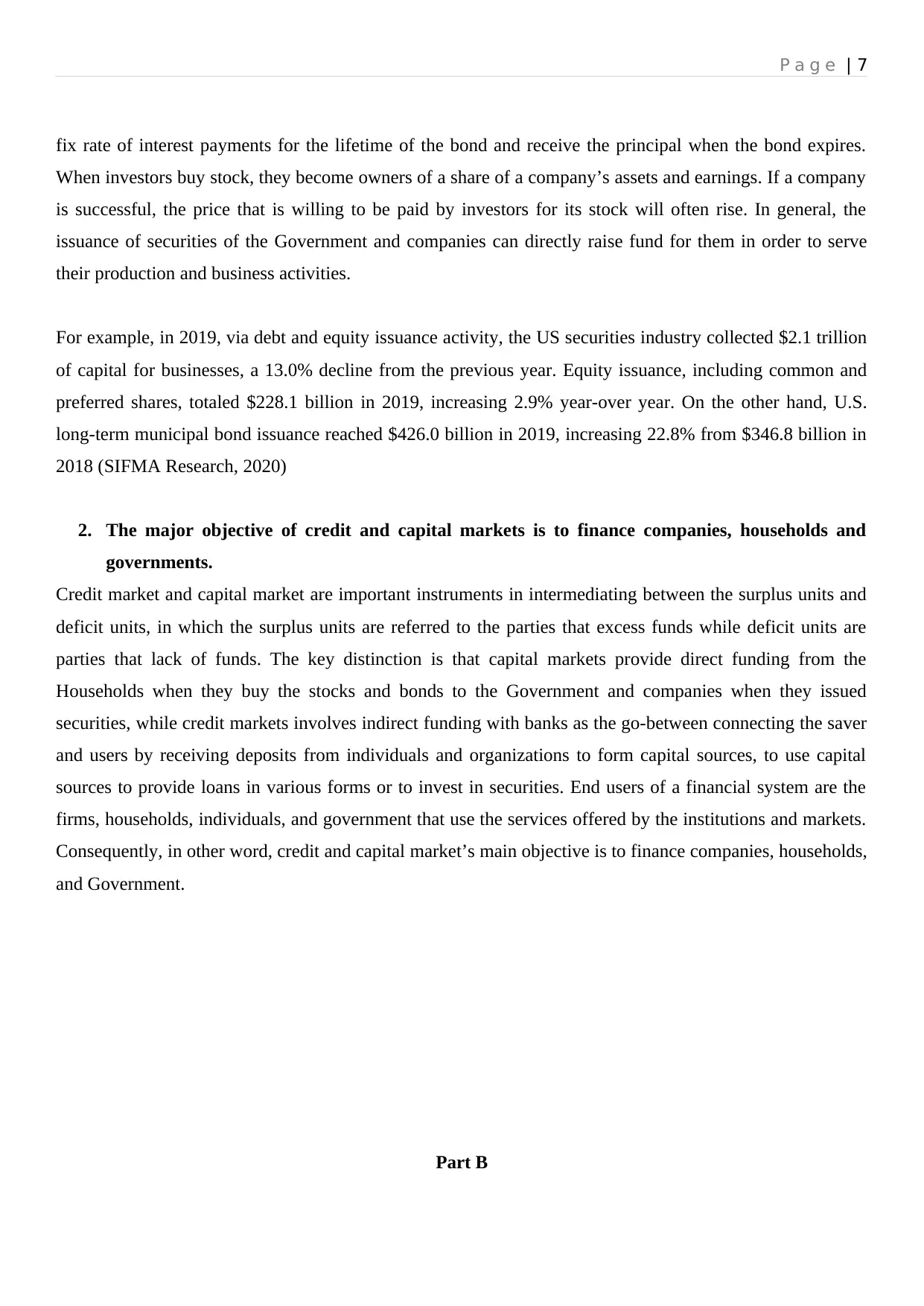
P a g e | 7
fix rate of interest payments for the lifetime of the bond and receive the principal when the bond expires.
When investors buy stock, they become owners of a share of a company’s assets and earnings. If a company
is successful, the price that is willing to be paid by investors for its stock will often rise. In general, the
issuance of securities of the Government and companies can directly raise fund for them in order to serve
their production and business activities.
For example, in 2019, via debt and equity issuance activity, the US securities industry collected $2.1 trillion
of capital for businesses, a 13.0% decline from the previous year. Equity issuance, including common and
preferred shares, totaled $228.1 billion in 2019, increasing 2.9% year-over year. On the other hand, U.S.
long-term municipal bond issuance reached $426.0 billion in 2019, increasing 22.8% from $346.8 billion in
2018 (SIFMA Research, 2020)
2. The major objective of credit and capital markets is to finance companies, households and
governments.
Credit market and capital market are important instruments in intermediating between the surplus units and
deficit units, in which the surplus units are referred to the parties that excess funds while deficit units are
parties that lack of funds. The key distinction is that capital markets provide direct funding from the
Households when they buy the stocks and bonds to the Government and companies when they issued
securities, while credit markets involves indirect funding with banks as the go-between connecting the saver
and users by receiving deposits from individuals and organizations to form capital sources, to use capital
sources to provide loans in various forms or to invest in securities. End users of a financial system are the
firms, households, individuals, and government that use the services offered by the institutions and markets.
Consequently, in other word, credit and capital market’s main objective is to finance companies, households,
and Government.
Part B
fix rate of interest payments for the lifetime of the bond and receive the principal when the bond expires.
When investors buy stock, they become owners of a share of a company’s assets and earnings. If a company
is successful, the price that is willing to be paid by investors for its stock will often rise. In general, the
issuance of securities of the Government and companies can directly raise fund for them in order to serve
their production and business activities.
For example, in 2019, via debt and equity issuance activity, the US securities industry collected $2.1 trillion
of capital for businesses, a 13.0% decline from the previous year. Equity issuance, including common and
preferred shares, totaled $228.1 billion in 2019, increasing 2.9% year-over year. On the other hand, U.S.
long-term municipal bond issuance reached $426.0 billion in 2019, increasing 22.8% from $346.8 billion in
2018 (SIFMA Research, 2020)
2. The major objective of credit and capital markets is to finance companies, households and
governments.
Credit market and capital market are important instruments in intermediating between the surplus units and
deficit units, in which the surplus units are referred to the parties that excess funds while deficit units are
parties that lack of funds. The key distinction is that capital markets provide direct funding from the
Households when they buy the stocks and bonds to the Government and companies when they issued
securities, while credit markets involves indirect funding with banks as the go-between connecting the saver
and users by receiving deposits from individuals and organizations to form capital sources, to use capital
sources to provide loans in various forms or to invest in securities. End users of a financial system are the
firms, households, individuals, and government that use the services offered by the institutions and markets.
Consequently, in other word, credit and capital market’s main objective is to finance companies, households,
and Government.
Part B
Paraphrase This Document
Need a fresh take? Get an instant paraphrase of this document with our AI Paraphraser
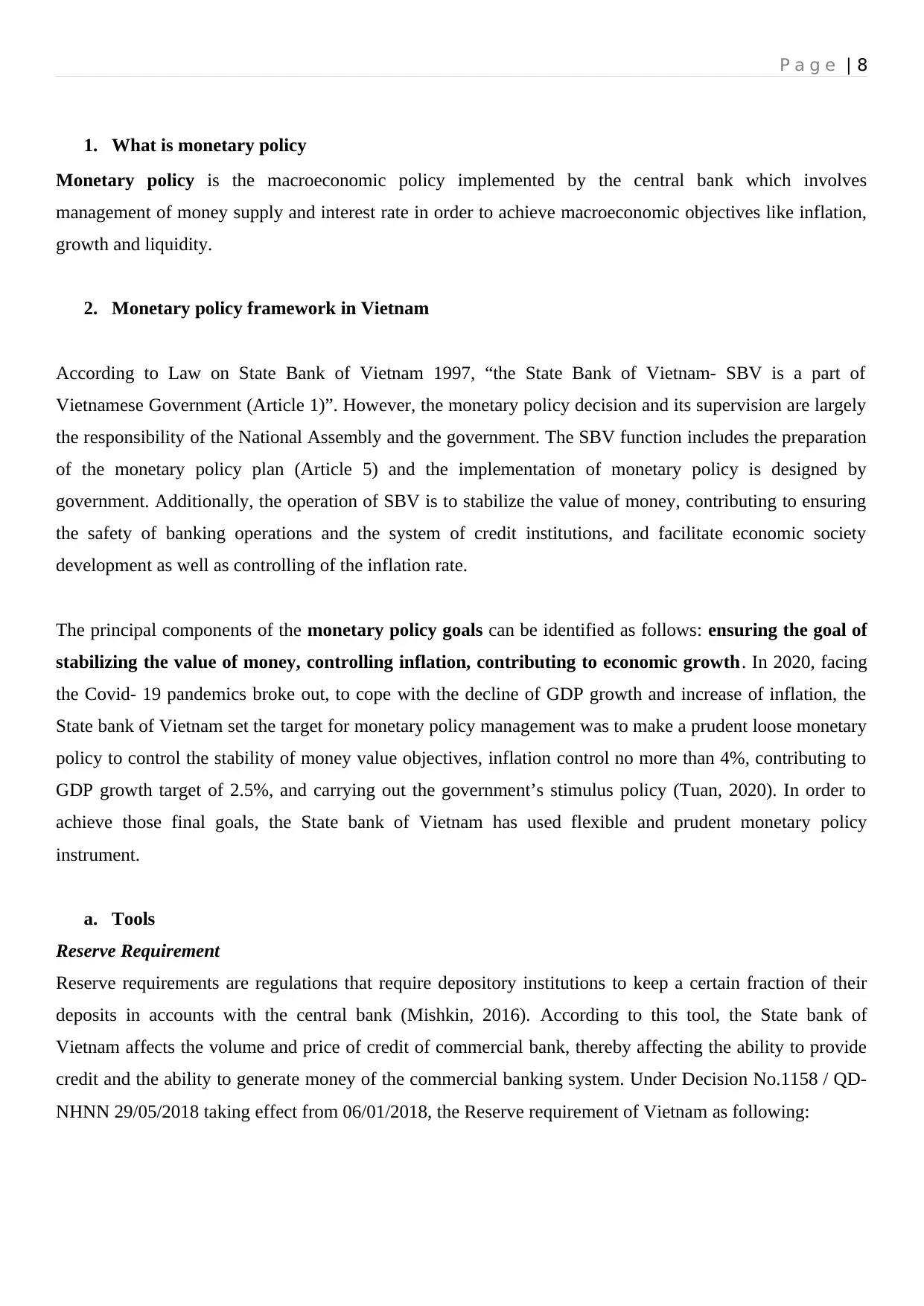
P a g e | 8
1. What is monetary policy
Monetary policy is the macroeconomic policy implemented by the central bank which involves
management of money supply and interest rate in order to achieve macroeconomic objectives like inflation,
growth and liquidity.
2. Monetary policy framework in Vietnam
According to Law on State Bank of Vietnam 1997, “the State Bank of Vietnam- SBV is a part of
Vietnamese Government (Article 1)”. However, the monetary policy decision and its supervision are largely
the responsibility of the National Assembly and the government. The SBV function includes the preparation
of the monetary policy plan (Article 5) and the implementation of monetary policy is designed by
government. Additionally, the operation of SBV is to stabilize the value of money, contributing to ensuring
the safety of banking operations and the system of credit institutions, and facilitate economic society
development as well as controlling of the inflation rate.
The principal components of the monetary policy goals can be identified as follows: ensuring the goal of
stabilizing the value of money, controlling inflation, contributing to economic growth. In 2020, facing
the Covid- 19 pandemics broke out, to cope with the decline of GDP growth and increase of inflation, the
State bank of Vietnam set the target for monetary policy management was to make a prudent loose monetary
policy to control the stability of money value objectives, inflation control no more than 4%, contributing to
GDP growth target of 2.5%, and carrying out the government’s stimulus policy (Tuan, 2020). In order to
achieve those final goals, the State bank of Vietnam has used flexible and prudent monetary policy
instrument.
a. Tools
Reserve Requirement
Reserve requirements are regulations that require depository institutions to keep a certain fraction of their
deposits in accounts with the central bank (Mishkin, 2016). According to this tool, the State bank of
Vietnam affects the volume and price of credit of commercial bank, thereby affecting the ability to provide
credit and the ability to generate money of the commercial banking system. Under Decision No.1158 / QD-
NHNN 29/05/2018 taking effect from 06/01/2018, the Reserve requirement of Vietnam as following:
1. What is monetary policy
Monetary policy is the macroeconomic policy implemented by the central bank which involves
management of money supply and interest rate in order to achieve macroeconomic objectives like inflation,
growth and liquidity.
2. Monetary policy framework in Vietnam
According to Law on State Bank of Vietnam 1997, “the State Bank of Vietnam- SBV is a part of
Vietnamese Government (Article 1)”. However, the monetary policy decision and its supervision are largely
the responsibility of the National Assembly and the government. The SBV function includes the preparation
of the monetary policy plan (Article 5) and the implementation of monetary policy is designed by
government. Additionally, the operation of SBV is to stabilize the value of money, contributing to ensuring
the safety of banking operations and the system of credit institutions, and facilitate economic society
development as well as controlling of the inflation rate.
The principal components of the monetary policy goals can be identified as follows: ensuring the goal of
stabilizing the value of money, controlling inflation, contributing to economic growth. In 2020, facing
the Covid- 19 pandemics broke out, to cope with the decline of GDP growth and increase of inflation, the
State bank of Vietnam set the target for monetary policy management was to make a prudent loose monetary
policy to control the stability of money value objectives, inflation control no more than 4%, contributing to
GDP growth target of 2.5%, and carrying out the government’s stimulus policy (Tuan, 2020). In order to
achieve those final goals, the State bank of Vietnam has used flexible and prudent monetary policy
instrument.
a. Tools
Reserve Requirement
Reserve requirements are regulations that require depository institutions to keep a certain fraction of their
deposits in accounts with the central bank (Mishkin, 2016). According to this tool, the State bank of
Vietnam affects the volume and price of credit of commercial bank, thereby affecting the ability to provide
credit and the ability to generate money of the commercial banking system. Under Decision No.1158 / QD-
NHNN 29/05/2018 taking effect from 06/01/2018, the Reserve requirement of Vietnam as following:
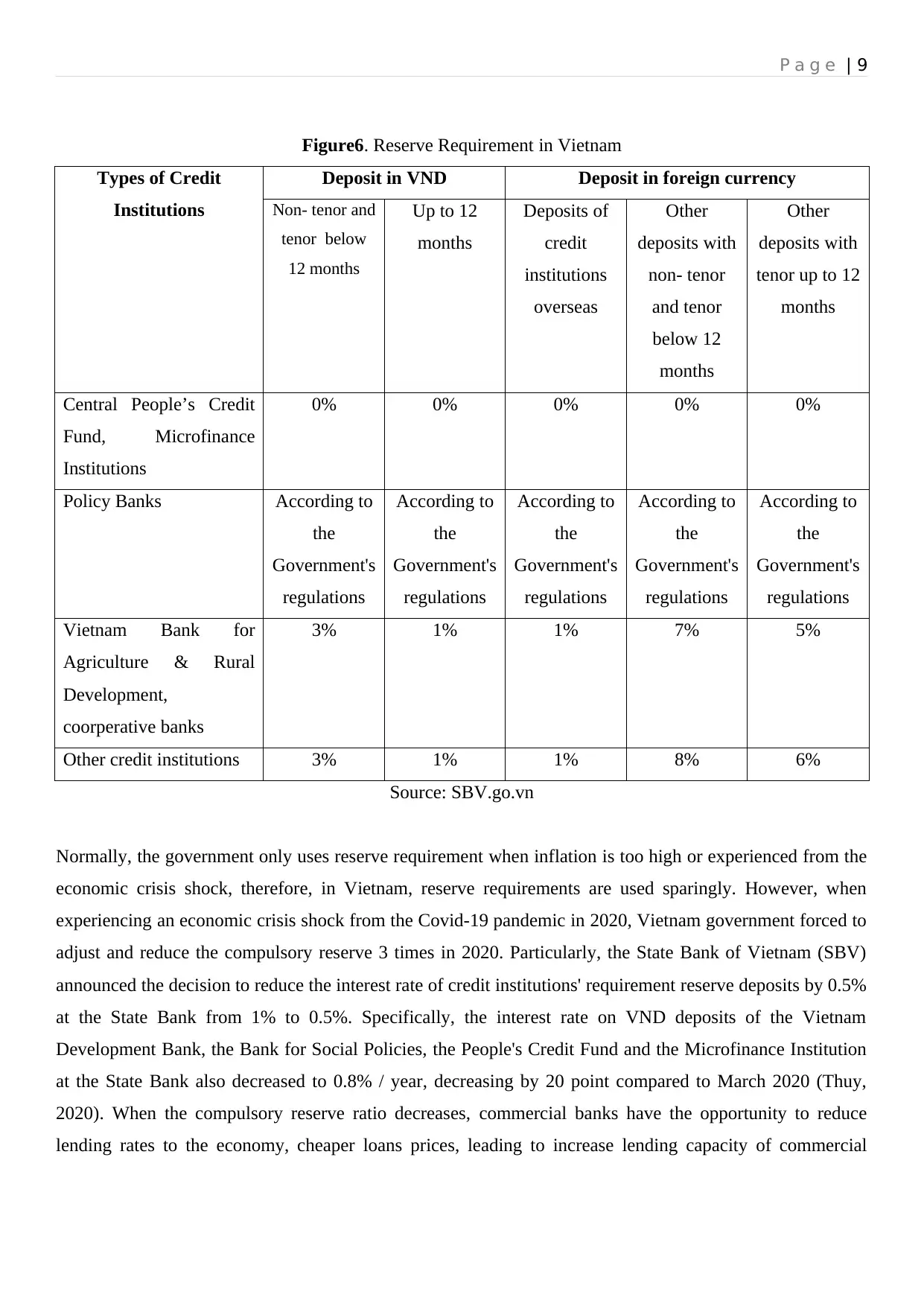
P a g e | 9
Figure6. Reserve Requirement in Vietnam
Types of Credit
Institutions
Deposit in VND Deposit in foreign currency
Non- tenor and
tenor below
12 months
Up to 12
months
Deposits of
credit
institutions
overseas
Other
deposits with
non- tenor
and tenor
below 12
months
Other
deposits with
tenor up to 12
months
Central People’s Credit
Fund, Microfinance
Institutions
0% 0% 0% 0% 0%
Policy Banks According to
the
Government's
regulations
According to
the
Government's
regulations
According to
the
Government's
regulations
According to
the
Government's
regulations
According to
the
Government's
regulations
Vietnam Bank for
Agriculture & Rural
Development,
coorperative banks
3% 1% 1% 7% 5%
Other credit institutions 3% 1% 1% 8% 6%
Source: SBV.go.vn
Normally, the government only uses reserve requirement when inflation is too high or experienced from the
economic crisis shock, therefore, in Vietnam, reserve requirements are used sparingly. However, when
experiencing an economic crisis shock from the Covid-19 pandemic in 2020, Vietnam government forced to
adjust and reduce the compulsory reserve 3 times in 2020. Particularly, the State Bank of Vietnam (SBV)
announced the decision to reduce the interest rate of credit institutions' requirement reserve deposits by 0.5%
at the State Bank from 1% to 0.5%. Specifically, the interest rate on VND deposits of the Vietnam
Development Bank, the Bank for Social Policies, the People's Credit Fund and the Microfinance Institution
at the State Bank also decreased to 0.8% / year, decreasing by 20 point compared to March 2020 (Thuy,
2020). When the compulsory reserve ratio decreases, commercial banks have the opportunity to reduce
lending rates to the economy, cheaper loans prices, leading to increase lending capacity of commercial
Figure6. Reserve Requirement in Vietnam
Types of Credit
Institutions
Deposit in VND Deposit in foreign currency
Non- tenor and
tenor below
12 months
Up to 12
months
Deposits of
credit
institutions
overseas
Other
deposits with
non- tenor
and tenor
below 12
months
Other
deposits with
tenor up to 12
months
Central People’s Credit
Fund, Microfinance
Institutions
0% 0% 0% 0% 0%
Policy Banks According to
the
Government's
regulations
According to
the
Government's
regulations
According to
the
Government's
regulations
According to
the
Government's
regulations
According to
the
Government's
regulations
Vietnam Bank for
Agriculture & Rural
Development,
coorperative banks
3% 1% 1% 7% 5%
Other credit institutions 3% 1% 1% 8% 6%
Source: SBV.go.vn
Normally, the government only uses reserve requirement when inflation is too high or experienced from the
economic crisis shock, therefore, in Vietnam, reserve requirements are used sparingly. However, when
experiencing an economic crisis shock from the Covid-19 pandemic in 2020, Vietnam government forced to
adjust and reduce the compulsory reserve 3 times in 2020. Particularly, the State Bank of Vietnam (SBV)
announced the decision to reduce the interest rate of credit institutions' requirement reserve deposits by 0.5%
at the State Bank from 1% to 0.5%. Specifically, the interest rate on VND deposits of the Vietnam
Development Bank, the Bank for Social Policies, the People's Credit Fund and the Microfinance Institution
at the State Bank also decreased to 0.8% / year, decreasing by 20 point compared to March 2020 (Thuy,
2020). When the compulsory reserve ratio decreases, commercial banks have the opportunity to reduce
lending rates to the economy, cheaper loans prices, leading to increase lending capacity of commercial
⊘ This is a preview!⊘
Do you want full access?
Subscribe today to unlock all pages.

Trusted by 1+ million students worldwide
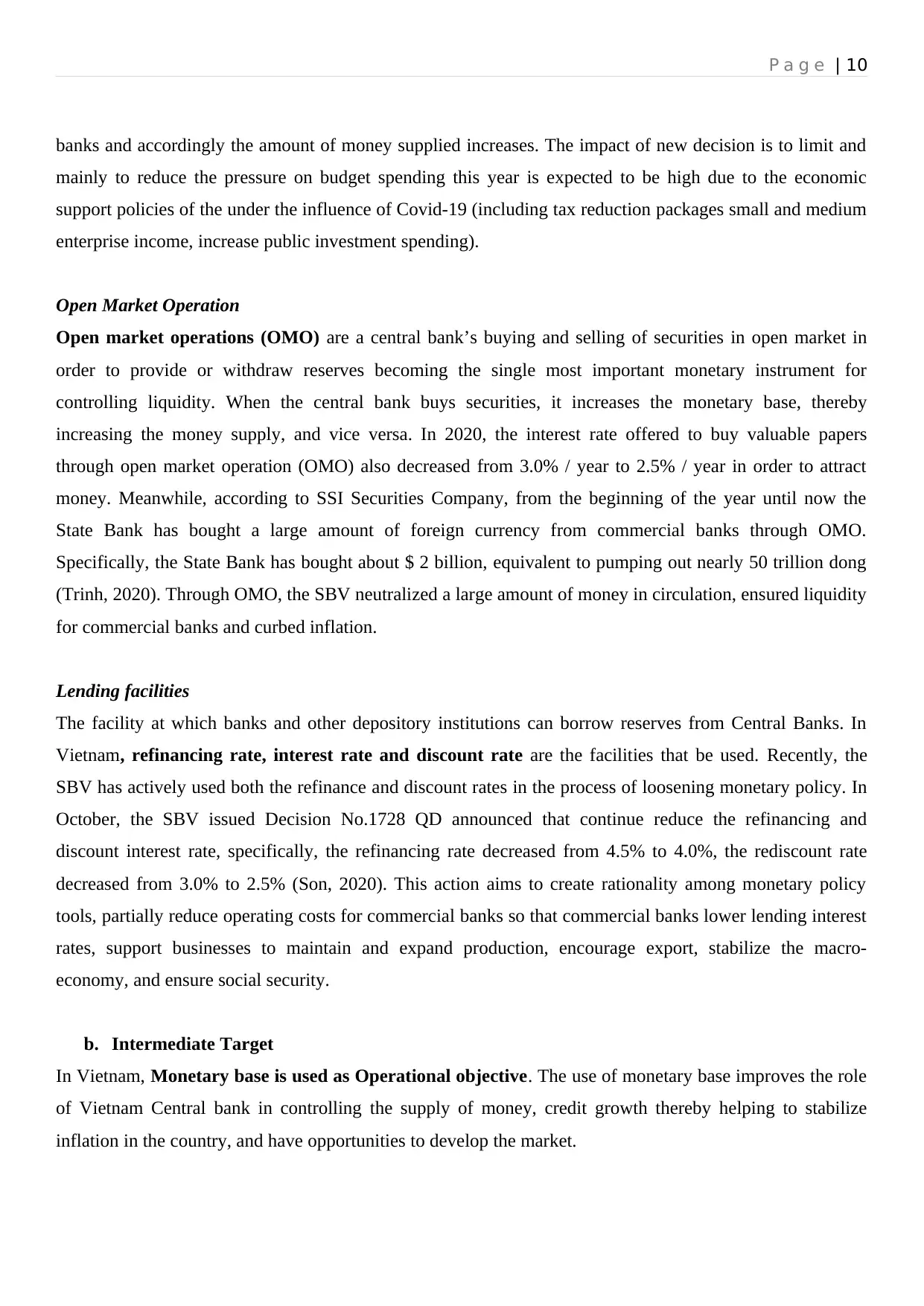
P a g e | 10
banks and accordingly the amount of money supplied increases. The impact of new decision is to limit and
mainly to reduce the pressure on budget spending this year is expected to be high due to the economic
support policies of the under the influence of Covid-19 (including tax reduction packages small and medium
enterprise income, increase public investment spending).
Open Market Operation
Open market operations (OMO) are a central bank’s buying and selling of securities in open market in
order to provide or withdraw reserves becoming the single most important monetary instrument for
controlling liquidity. When the central bank buys securities, it increases the monetary base, thereby
increasing the money supply, and vice versa. In 2020, the interest rate offered to buy valuable papers
through open market operation (OMO) also decreased from 3.0% / year to 2.5% / year in order to attract
money. Meanwhile, according to SSI Securities Company, from the beginning of the year until now the
State Bank has bought a large amount of foreign currency from commercial banks through OMO.
Specifically, the State Bank has bought about $ 2 billion, equivalent to pumping out nearly 50 trillion dong
(Trinh, 2020). Through OMO, the SBV neutralized a large amount of money in circulation, ensured liquidity
for commercial banks and curbed inflation.
Lending facilities
The facility at which banks and other depository institutions can borrow reserves from Central Banks. In
Vietnam, refinancing rate, interest rate and discount rate are the facilities that be used. Recently, the
SBV has actively used both the refinance and discount rates in the process of loosening monetary policy. In
October, the SBV issued Decision No.1728 QD announced that continue reduce the refinancing and
discount interest rate, specifically, the refinancing rate decreased from 4.5% to 4.0%, the rediscount rate
decreased from 3.0% to 2.5% (Son, 2020). This action aims to create rationality among monetary policy
tools, partially reduce operating costs for commercial banks so that commercial banks lower lending interest
rates, support businesses to maintain and expand production, encourage export, stabilize the macro-
economy, and ensure social security.
b. Intermediate Target
In Vietnam, Monetary base is used as Operational objective. The use of monetary base improves the role
of Vietnam Central bank in controlling the supply of money, credit growth thereby helping to stabilize
inflation in the country, and have opportunities to develop the market.
banks and accordingly the amount of money supplied increases. The impact of new decision is to limit and
mainly to reduce the pressure on budget spending this year is expected to be high due to the economic
support policies of the under the influence of Covid-19 (including tax reduction packages small and medium
enterprise income, increase public investment spending).
Open Market Operation
Open market operations (OMO) are a central bank’s buying and selling of securities in open market in
order to provide or withdraw reserves becoming the single most important monetary instrument for
controlling liquidity. When the central bank buys securities, it increases the monetary base, thereby
increasing the money supply, and vice versa. In 2020, the interest rate offered to buy valuable papers
through open market operation (OMO) also decreased from 3.0% / year to 2.5% / year in order to attract
money. Meanwhile, according to SSI Securities Company, from the beginning of the year until now the
State Bank has bought a large amount of foreign currency from commercial banks through OMO.
Specifically, the State Bank has bought about $ 2 billion, equivalent to pumping out nearly 50 trillion dong
(Trinh, 2020). Through OMO, the SBV neutralized a large amount of money in circulation, ensured liquidity
for commercial banks and curbed inflation.
Lending facilities
The facility at which banks and other depository institutions can borrow reserves from Central Banks. In
Vietnam, refinancing rate, interest rate and discount rate are the facilities that be used. Recently, the
SBV has actively used both the refinance and discount rates in the process of loosening monetary policy. In
October, the SBV issued Decision No.1728 QD announced that continue reduce the refinancing and
discount interest rate, specifically, the refinancing rate decreased from 4.5% to 4.0%, the rediscount rate
decreased from 3.0% to 2.5% (Son, 2020). This action aims to create rationality among monetary policy
tools, partially reduce operating costs for commercial banks so that commercial banks lower lending interest
rates, support businesses to maintain and expand production, encourage export, stabilize the macro-
economy, and ensure social security.
b. Intermediate Target
In Vietnam, Monetary base is used as Operational objective. The use of monetary base improves the role
of Vietnam Central bank in controlling the supply of money, credit growth thereby helping to stabilize
inflation in the country, and have opportunities to develop the market.
Paraphrase This Document
Need a fresh take? Get an instant paraphrase of this document with our AI Paraphraser
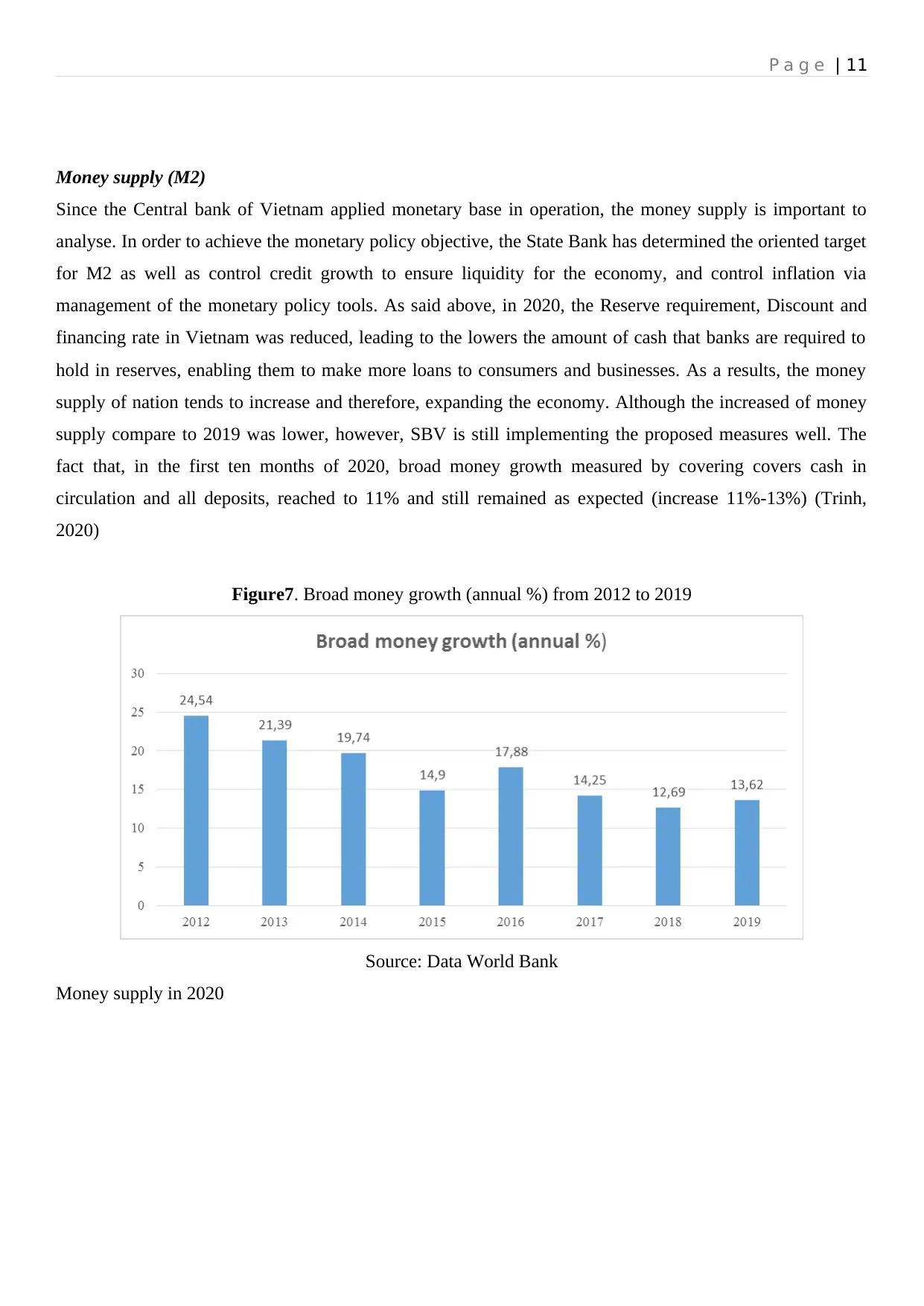
P a g e | 11
Money supply (M2)
Since the Central bank of Vietnam applied monetary base in operation, the money supply is important to
analyse. In order to achieve the monetary policy objective, the State Bank has determined the oriented target
for M2 as well as control credit growth to ensure liquidity for the economy, and control inflation via
management of the monetary policy tools. As said above, in 2020, the Reserve requirement, Discount and
financing rate in Vietnam was reduced, leading to the lowers the amount of cash that banks are required to
hold in reserves, enabling them to make more loans to consumers and businesses. As a results, the money
supply of nation tends to increase and therefore, expanding the economy. Although the increased of money
supply compare to 2019 was lower, however, SBV is still implementing the proposed measures well. The
fact that, in the first ten months of 2020, broad money growth measured by covering covers cash in
circulation and all deposits, reached to 11% and still remained as expected (increase 11%-13%) (Trinh,
2020)
Figure7. Broad money growth (annual %) from 2012 to 2019
Source: Data World Bank
Money supply in 2020
Money supply (M2)
Since the Central bank of Vietnam applied monetary base in operation, the money supply is important to
analyse. In order to achieve the monetary policy objective, the State Bank has determined the oriented target
for M2 as well as control credit growth to ensure liquidity for the economy, and control inflation via
management of the monetary policy tools. As said above, in 2020, the Reserve requirement, Discount and
financing rate in Vietnam was reduced, leading to the lowers the amount of cash that banks are required to
hold in reserves, enabling them to make more loans to consumers and businesses. As a results, the money
supply of nation tends to increase and therefore, expanding the economy. Although the increased of money
supply compare to 2019 was lower, however, SBV is still implementing the proposed measures well. The
fact that, in the first ten months of 2020, broad money growth measured by covering covers cash in
circulation and all deposits, reached to 11% and still remained as expected (increase 11%-13%) (Trinh,
2020)
Figure7. Broad money growth (annual %) from 2012 to 2019
Source: Data World Bank
Money supply in 2020
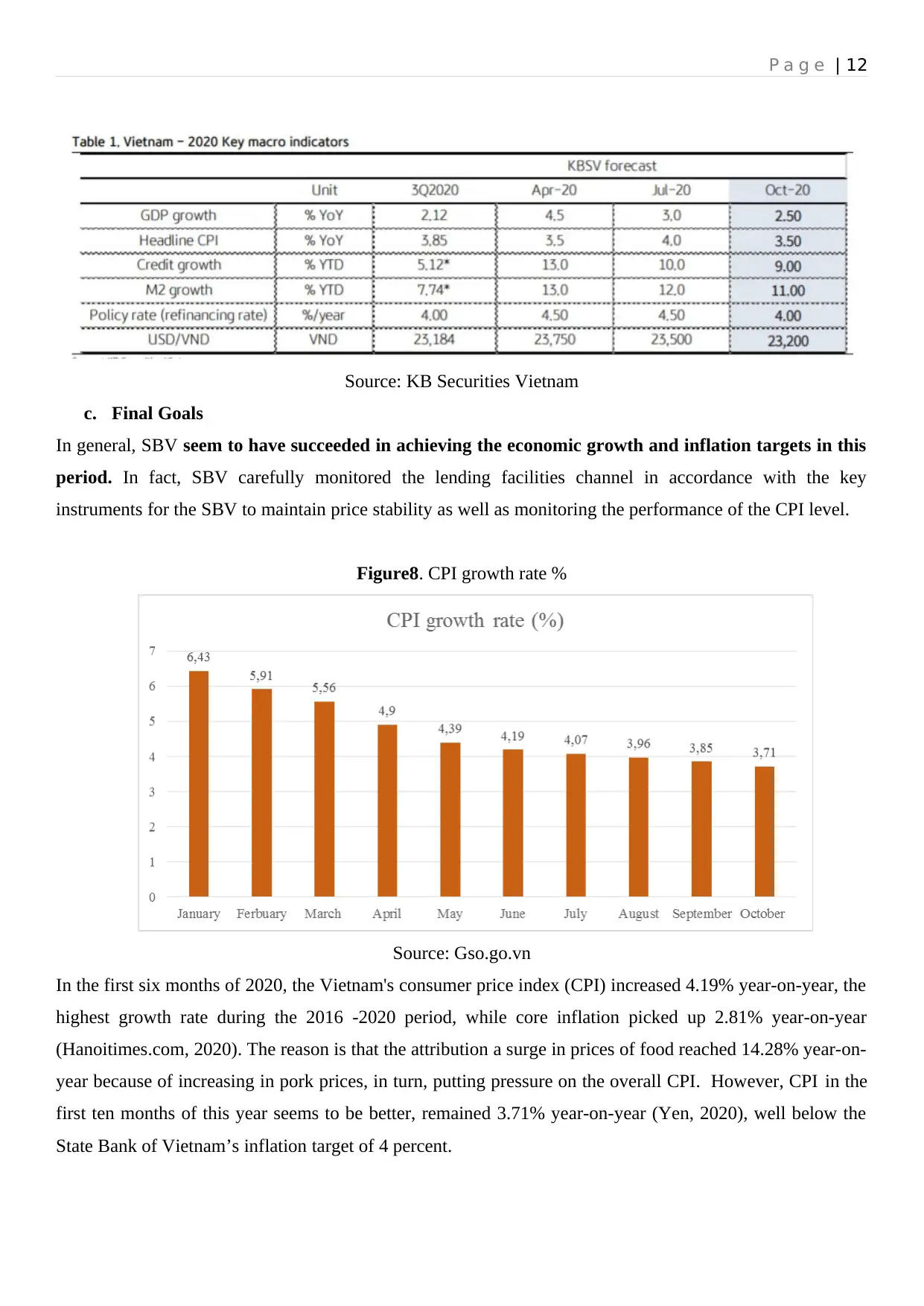
P a g e | 12
Source: KB Securities Vietnam
c. Final Goals
In general, SBV seem to have succeeded in achieving the economic growth and inflation targets in this
period. In fact, SBV carefully monitored the lending facilities channel in accordance with the key
instruments for the SBV to maintain price stability as well as monitoring the performance of the CPI level.
Figure8. CPI growth rate %
Source: Gso.go.vn
In the first six months of 2020, the Vietnam's consumer price index (CPI) increased 4.19% year-on-year, the
highest growth rate during the 2016 -2020 period, while core inflation picked up 2.81% year-on-year
(Hanoitimes.com, 2020). The reason is that the attribution a surge in prices of food reached 14.28% year-on-
year because of increasing in pork prices, in turn, putting pressure on the overall CPI. However, CPI in the
first ten months of this year seems to be better, remained 3.71% year-on-year (Yen, 2020), well below the
State Bank of Vietnam’s inflation target of 4 percent.
Source: KB Securities Vietnam
c. Final Goals
In general, SBV seem to have succeeded in achieving the economic growth and inflation targets in this
period. In fact, SBV carefully monitored the lending facilities channel in accordance with the key
instruments for the SBV to maintain price stability as well as monitoring the performance of the CPI level.
Figure8. CPI growth rate %
Source: Gso.go.vn
In the first six months of 2020, the Vietnam's consumer price index (CPI) increased 4.19% year-on-year, the
highest growth rate during the 2016 -2020 period, while core inflation picked up 2.81% year-on-year
(Hanoitimes.com, 2020). The reason is that the attribution a surge in prices of food reached 14.28% year-on-
year because of increasing in pork prices, in turn, putting pressure on the overall CPI. However, CPI in the
first ten months of this year seems to be better, remained 3.71% year-on-year (Yen, 2020), well below the
State Bank of Vietnam’s inflation target of 4 percent.
⊘ This is a preview!⊘
Do you want full access?
Subscribe today to unlock all pages.

Trusted by 1+ million students worldwide
1 out of 18
Related Documents
Your All-in-One AI-Powered Toolkit for Academic Success.
+13062052269
info@desklib.com
Available 24*7 on WhatsApp / Email
![[object Object]](/_next/static/media/star-bottom.7253800d.svg)
Unlock your academic potential
Copyright © 2020–2025 A2Z Services. All Rights Reserved. Developed and managed by ZUCOL.




